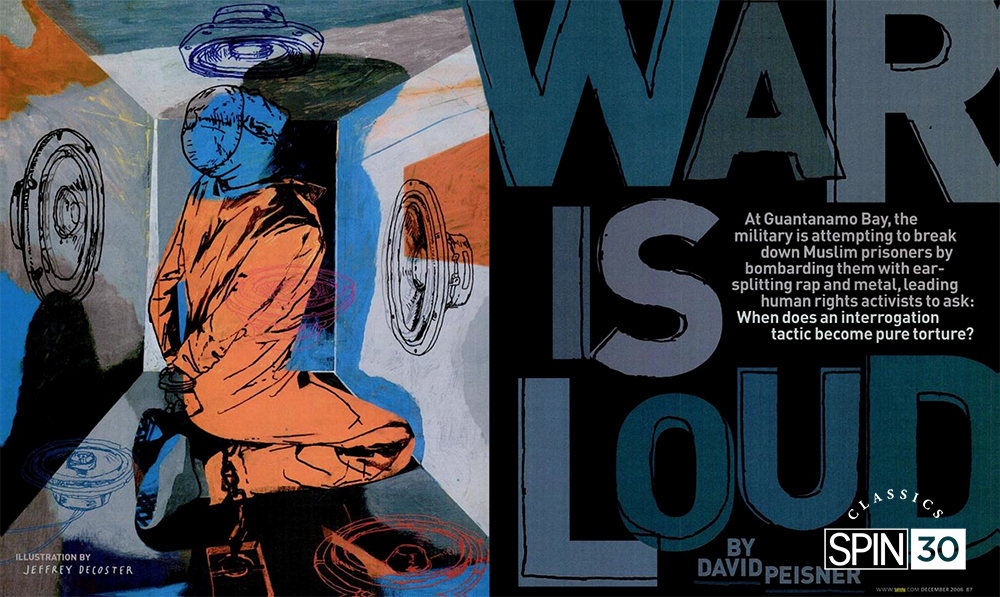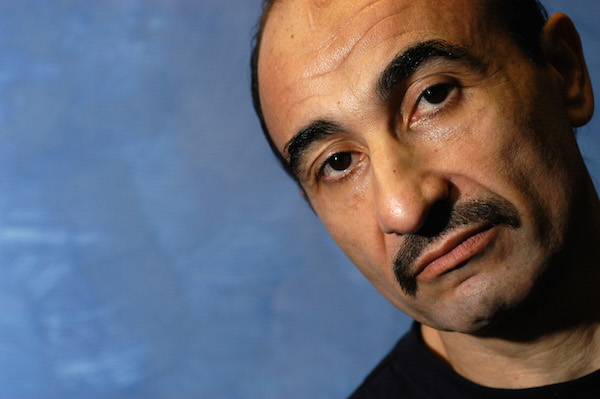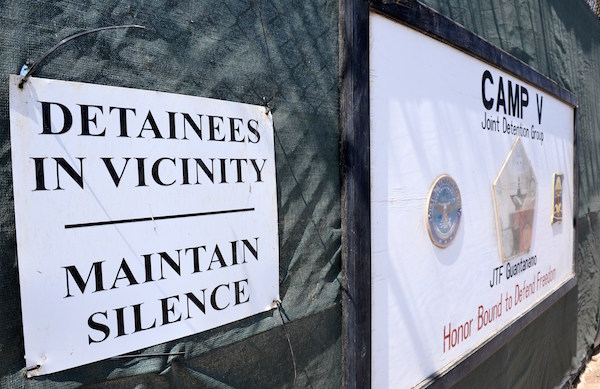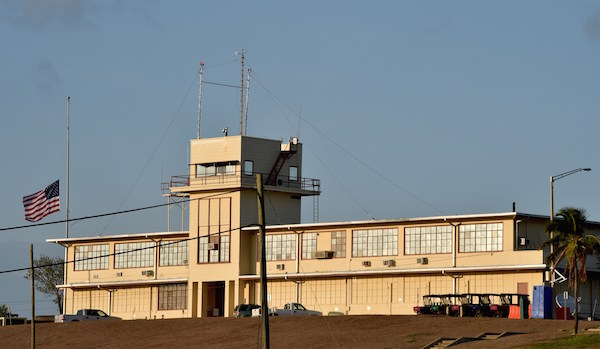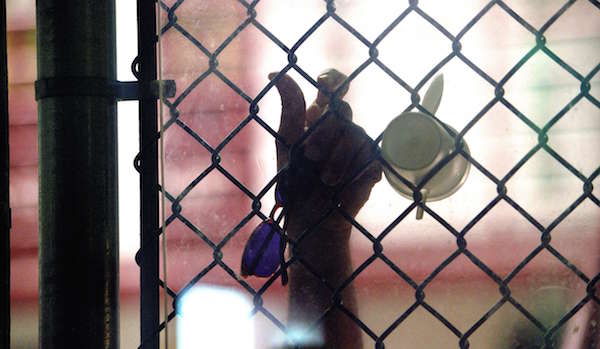[This story was originally published in the December 2006 issue of SPIN. In honor of SPIN’s 30th anniversary, we’ve republished this piece as part of our ongoing “30 Years, 30 Stories” series.]
Writer’s note, 2009: When I was researching this story on the U.S. military and intelligence agencies’ use of music as an interrogation tool back in 2006, I spoke to A. John Radsan, who had been assistant general counsel at the CIA from 2002 to 2004. I was specifically interested in trying to nail down exactly who had authorized the use of music in this manner. I asked Radsan whether the CIA had authorized the use of music in interrogations. For obvious reasons, he could only discuss information that had been declassified and was in the public record. He pointed me to an obscure footnote in a memo issued by the Office of Legal Counsel in late 2004 that referred obliquely to the idea that there were other memos that were still classified that detailed exactly what interrogation methods could and couldn’t be used by the CIA. “That footnote is as much confirmation as I could give you,” he told me.
So when the Obama administration declassified this latest batch of “torture memos” on April 16, I expected a treasure trove of information on music’s place in the CIA’s interrogation program. In fact, there’s no mentions of music at all. There is, however, a footnote in one of the memos, originally written in 2005, that notes that, “The CIA maintains ‘detention conditions’ at all of its detention facilities,” that include exposure to “white noise/loud sounds (not to exceed 79 decibels)” during portions of the interrogation. But because the CIA didn’t classify these as “interrogation techniques,” this particular memo doesn’t assess their lawfulness (though it does note that according to the Occupational Safety and Health Administration there is “no risk of permanent hearing loss from continuous 24-hour-per-day exposure to noise of up to 82 decibels.”) Notwithstanding the fact that it takes an Orwellian linguistic backflip to avoid characterizing noise blasted during interrogations (and perhaps, for 24 hours straight) as an “interrogation technique,” I read this footnote to mean that the use of music is likely authorized in a different, still classified memo that judges the lawfulness of the CIA’s “detention conditions.” As Radsan told me back then, CIA officers had been burned in the past and it’s unlikely they would simply be improvising, blasting an Eminem album at a detainee without first receiving written, legal authorization to do so. “If I were an interrogator,” Radsan said, “I would make sure I had some guidance and approval before I did something like that.”
What these new “torture memos” do make clear, though, is that Greg Hartley, the former SERE instructor and interrogation trainer whom I spoke to for the story, was exactly right when he surmised that the way all these new “enhanced interrogation” techniques ended up in the arsenals of American interrogators was through SERE, the Special Forces school that trains American military personal to resist interrogation by foreign governments. As he said back then, “a lot of what’s happening, a lot of the stuff you see that has gone wrong” — everything from loud music to stress positions to waterboarding — “I think is someone trying to overlay SERE techniques to interrogation.” This, as it turns out, is exactly what happened. (It’s worth pointing out that with regards to the most controversial interrogation technique authorized in these memos — waterboarding — Hartley, who had both been on giving and receiving end of this tactic at SERE said, “That’s a horrible thing — I can’t imagine they ever approved that.”) He also said that SERE was never intended to be interrogation training. It was meant to mimic the brutal tactics of our enemies, which were known to produce false confessions. As he put it in what is probably my favorite quote in the story, “Just because someone gives you a good blowjob doesn’t mean you’re going to be able to give one too.”

Also Read
THE DAY THE MUSIC DIED
SPIN‘s Original 2006 Story:
In May 2003, Shafiq Rasul was led from his cell at the Camp Delta detention facility in Guantanamo Bay, Cuba, to a small, drab interrogation booth. He sat down and a military police officer chained his leg irons to a metal ring in the center of the linoleum floor. Rasul had grown accustomed to this procedure since his arrival in Cuba nearly 18 months earlier. Every few weeks he’d be brought into the booth and questioned about people he knew, places he’d been, and what he and two friends, Ruhal Ahmed and Asif Iqbal — all English citizens in their 20s — were doing in Afghanistan in late 2001. This time was different. An interrogator walked into the booth, pressed play on a nearby stereo, and walked out. Rasul immediately recognized the sound coming from the speakers: It was Eminem’s “Kim.” “It was weird because I’d heard it before,” he says. “I’ve probably got the album at home somewhere. [They] just put Eminem on and left, and I thought, ‘What the hell is going on here?'”
Rasul sat in the room with “Kim” on repeat. He wasn’t particularly bothered (“It was just like playing music at home, but chained to the floor”), and after a few hours MPs returned him to his cell.
It wasn’t long before he was back in the booth. This time, the room was pitch black except for the irregular flashes of a strobe light. Eminem had been replaced by loud, menacing heavy metal. The air-conditioning had been cranked way up, and Rasul was short-shackled — his wrists fastened to his ankles, then shackled to the ring in the floor in what is known as a “stress position.” He was left there for hours. “Being in that position is really stressful on your back,” he says. “If you try to move, the chains start digging into your feet and wrists.”
https://youtube.com/watch?v=OcUgsvpchms
Rasul endured such “interrogation sessions” every day, sometimes twice a day, for nearly three weeks. Often, there was little or no interrogation taking place. After up to 12 hours in the booth with raging metal as his only companion, he’d just be marched back to his cell-now on the prison’s isolation block.
Rasul, Ahmed, and Iqbal had been captured in Afghanistan in November 2001 by a Northern Alliance militia, and then transferred to U.S. custody. U.S. intelligence seemed to lose interest in Rasul after his first few months in Guantanamo. Even if they doubted his story — that he and his friends had traveled to Pakistan for a wedding, then entered Afghanistan after the U.S. invasion to do humanitarian work — he seemed to know next to nothing about Al Qaeda and was interrogated infrequently. But in 2003, U.S. agents found what they believed was a smoking gun: a videotape apparently showing the three men sitting in on an August 2000 meeting with Osama bin Laden and lead 9/11 hijacker Mohammed Atta. The increasing harshness of Rasul’s treatment directly corresponded to this discovery and soon began having its desired effect. “It just starts playing with you,” he says. “Even if you were shouting, the music was too loud — nobody would be able to hear you. You’re there for hours and hours, and they’re constantly playing the same music. All that builds up. You start hallucinating.”
Rasul’s interrogators showed him the video and pressed him to admit he was at the meeting. After he initially denied the charge, the weeks-long barrage of metal, extreme cold, and strobe lights did its job and Rasul confessed.
There was only one problem: In August 2000, Shafiq Rasul couldn’t have been breaking bread with bin Laden because, as investigators would soon confirm, he was attending university and working at the electronics store Curry’s back in England. In early 2004, Rasul, Ahmed, and Iqbal were released without charges.
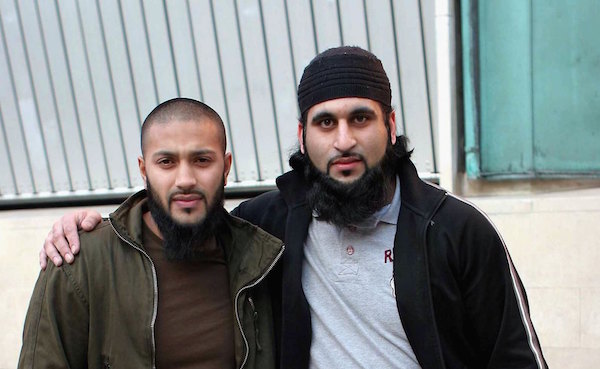
Rasul’s ordeal may seem bizarre and disturbing, but it’s hardly unique. Over the last five years, loud music has quietly become a valued tool in the Bush administration’s war on terror. The list of artists reportedly drafted to help break down prisoners for interrogation reads like an eclectic iPod playlist, heavy on rap (2Pac, Dr. Dre) and hard rock and metal (Metallica, Marilyn Manson, Rage Against the Machine), but also sprinkled with pop (Britney Spears, Matchbox Twenty), classic rock (Aerosmith, Meat Loaf), and the odd head-scratcher (Stanley Brothers, Barney the dinosaur).
Music isn’t a new military weapon. Probably the first commander to order its use was, perhaps not coincidentally, the same one often viewed as the architect of the Bush administration’s Middle East policy. According to the Old Testament, during the siege of Jericho by the Israelites, God tells Joshua to have priests march around the city blowing trumpets for seven days. On the seventh day, “at the blast of the rams’ horns, when you hear the trumpet sound…the city wall will collapse, and the army will advance” (Joshua 6:5). Joshua follows his orders, Jericho’s walls crumble, and the Israelites rush in to slaughter every single resident, save a prostitute and her family.
The Jericho model has more or less persevered into modern times. U.S. psychological operations (PsyOp) units began experimenting with blasting music at enemies in Vietnam and infamously rocked a 1989 standoff with Panamanian dictator Manuel Noriega. But it’s only been in the past few decades that music and other sounds began turning up during interrogations. The British blared white noise at Irish Republican Army suspects in the ’70s but swore off the practice after the European Court of Human Rights ruled in 1977 that it was “degrading and inhuman.” Israel’s military employed loud music until 1999, when an Israeli Supreme Court judged that this exposure “causes the suspect suffering. It does not fall within the scope of…a fair and effective interrogation.”
Perhaps the first example of music being used by the U.S. for interrogations came post-9/11, in spring 2002, during the questioning of suspected Al Qaeda operative Abu Zubaydah. According to The New York Times, while in custody at a secret CIA facility in Thailand, Zubaydah was subjected to “deafening blasts of music by groups like Red Hot Chili Peppers.”
Nobody in the U.S. government seems eager to take credit for this innovation. Loud music isn’t among the standard interrogation tactics described in the Army Field Manual. It’s never mentioned in any of the declassified memos to and from Defense Secretary Donald Rumsfeld’s office concerning the authorization of special “enhanced” techniques for use against particularly resistant detainees. It’s not taught at the U.S. Army Intelligence School at Fort Huachuca, Arizona, where military interrogators are trained. And the CIA refuses to comment at all on its interrogation practices.
Yet it’s clear that music has been employed repeatedly to help set conditions for fruitful interrogations. What’s far less clear is how it came to be used, if it’s legal, if it’s effective, and whether the practice will continue. The answers to those questions are hardly straightforward but offer a window into the kind of war we’ve been fighting since 9/11 and the kind of war we’re willing to continue fighting five years after.
Mamdouh Habib, an Egypt-born Australian citizen, was hauled off a bus by Pakistani police in Karachi in early October 2001, weeks before the U.S. invasion of neighboring Afghanistan. He was soon transferred, allegedly by U.S. agents, to Egypt, where he endured beatings, electric shock, and sonically enhanced interrogation methods. “What surprised me is they used English[-language] music,” Habib says. “They put headphones on me, then put on the music very loud.” After six months in Egypt, Habib was transferred to a U.S. facility in Afghanistan, then flown to Guantanamo. He was in such bad shape at that point that he has almost no memory of his first year in Cuba. Habib says his interrogators asked him about his treatment in Egypt, and after learning the things that troubled him most (threats to his family, loud music), they proceeded to apply them themselves. “They were trying to make me crazy,” he says. “They try to take your mind away from you.” To some extent it worked. “Even today, when I hear any loud noise, I get disturbed.”
Dr. Stephen Xenakis, a psychiatrist, retired brigadier general, and former commander of the Southeast Regional Army Medical Command, says this sort of musical bombardment can indeed cause permanent damage. “It’s really traumatizing to the brain,” he says. “It will lead to anxiety and the kind of symptoms you get with post-traumatic stress disorder.”
Habib, who the U.S. had said admitted to having prior knowledge of the 9/11 attacks and training some of the hijackers-confessions Habib says were made only under duress — was released without charges in January 2005.
Tom, who requested his last name be withheld for security reasons, began working as an interrogator in the late ’80s. He served in a senior position at Guantanamo in early 2002 and in a similar capacity in Afghanistan. After leaving the military, he worked for a government agency he’s not permitted to name, both in Iraq and at secret prisons around the world, often dealing with those considered “high value” prisoners. He cautions against taking ex-detainees at their word, noting that they’ve learned to “exploit the media.” In particular, he calls Shafiq Rasul, whom he interrogated in Guantanamo, “a lying sack of shit.” (The episode Rasul described concerning Eminem and heavy metal occurred more than a year after Tom had left Guantanamo.) It’s nearly impossible to confirm the details of many ex-detainees’ allegations, but the incidents Rasul, Habib, and others describe fit a pattern consistent not only with one another’s stories, but also with the U.S. government’s own investigations into reported abuse.
That said, Tom and other interrogators I spoke to maintain that the use of music in interrogations was anything but standard operating procedure. “It was definitely not part of military doctrine,” Tom says. The music itself would usually be chosen by the interrogators either from CDs or downloaded off a file-sharing service. Boom boxes or iPod speakers might be borrowed from a soldier or purchased at the military PX or in a nearby town. Occasionally, music would be broadcast over the prison’s public-address system.
Shortly after Tom arrived at Guantanamo, some PsyOp soldiers convinced the guards to play Neil Diamond’s “America” over the loudspeakers. “It was to try to keep the prisoners agitated and from talking to one another,” he explains. “We wanted to prevent them from keeping each others’ spirits up and emboldening one another to resist interrogation.” The results were disastrous. “It just about caused an all-out riot. Strict interpreters of Islam are forbidden from listening to music. The whole place basically erupted.”
Tom makes an ethical distinction between blasting music for the purposes of interrogation and using it to disorient a recent capture. “If [the detainee] is accustomed to his surroundings and you force him to listen to Limp Bizkit, that’s clearly an interrogation tactic,” he says. “That would only be used in very rare situations, to annoy someone to the point where their only way out is you. To me, the only purpose of that is to drive somebody nuts, and that constitutes torture.
“When we use it at remote facilities, it’s to maintain what we call ‘the shock of capture,'” Tom continues. “The hardest cases to break are those guys that sit there and smugly smile because they know we’re not going to beat them up or rip their fingernails out. So we use music to keep them from knowing what time it is, from communicating with others or hearing sounds that would help orient them.”
For better or worse, these were distinctions Tom and others made on the fly. The agency had trained him in the use of white noise on prisoners. Switching to music was simply an innovation made on the ground. He also says the agency authorized all the techniques he employed at these secret sites. But the standard often used to determine how far interrogators could go was rather haphazard. “You couldn’t keep somebody up while you went to bed,” he explains. “If you can stay up, they can stay up. If you could take the music, they can take the music.”
Mark Hadsell is a 41-year-old mechanical engineer and, until recently, an Army Reservist with the 361st Psychological Operations Unit. From February 2003 until April 2004, he led a mobile, three-man PsyOp team in Iraq. He says he blasted music when assisting interrogators in the questioning of insurgents in al-Qa’im, a town near the Syrian border. “We had key prisoners that had information we knew would be useful in finding their counterparts who were ambushing us,” he explains. “So we [played] Metallica’s ‘Enter Sandman’ on repeat for a 24-hour period as sleep deprivation. You wanted to get [the prisoners] emotionally exhausted. Say you’re up for 24 hours straight, music pounding in the background — nine times out of ten you’ll just answer a question without thinking.”
Hadsell says he had authorization to try this technique from his commanders but claims the idea was his own, as were the details of its use: “I wanted to see if it would actually work. I just picked music I knew they didn’t like.”
One interrogator who served in several prisons in Iraq, and spoke on the condition of anonymity, says the commanding officer at one facility ordered the use of music on some prisoners along with other techniques, including strobe lights, stress positions, and air-conditioning set to hypothermia-inducing levels. The choice of songs, though, was the interrogator’s. “I was the guy out there all night, sitting with the [detainee], so I was the DJ,” he says. “We started out playing stuff we’d gotten from the MPs, which was, like, unlistenable death metal. But we had to sit there and listen, too, so after a while, I’d play whatever I wanted.” That included James Taylor, and Janeane Garofalo and Ben Stiller reading an audiobook about their friendship. “They hated Janeane Garofalo.”
The purpose, he confirms, was to keep detainees from thinking. “The way we talked about it was ‘prolonging the shock of capture,'” he says. “Frankly, it wasn’t terribly effective, but that’s what our leaders were coming up with over there.” This interrogator says he’d heard about such techniques at the Army Intelligence School but was never trained to use them. “We were told these methods were illegal because we were following the Geneva Conventions. But when we got to Iraq, it was decided these guys weren’t covered by the Geneva Conventions.”
In actuality, the Bush administration’s selective interpretation and application of the Geneva Conventions makes it less than clear if, when, and for whom the rules’ protections against abusive treatment and torture were deemed applicable in Iraq. From the beginning of the conflict, the administration asserted that the Geneva Conventions would apply to all Iraqi detainees but left a loophole open for foreigners captured on Iraqi soil. In this obtuse legal environment — an environment, it’s worth noting, in which MPs at a prison in Abu Ghraib would brazenly photograph prisoners being sexually humiliated and threatened with dogs — it’s hardly surprising interrogators would assume playing Metallica at ear-splitting volume would be inbounds. And a September 14, 2003, memo from the commander in Iraq, Lieutenant General Ricardo Sanchez, hardly clarified things. In the document, Sanchez authorized a host of techniques that human rights groups claimed violated not only the Geneva Conventions, but also the United Nations Convention Against Torture and Other Cruel, Inhuman and Degrading Treatment, which the U.S. ratified in 1994. Among these techniques (many of which would be rescinded in a new memo a month later) were “yelling, loud music, and light control: used to create fear, disorient detainee, and prolong capture shock.”
According to Pentagon spokesman Lieutenant Colonel Mark Ballesteros, music was only sanctioned on a case-by-case basis with specific approval by Sanchez, and Sanchez never actually gave this personal authorization, which means any soldier in Iraq blasting a detainee with music (or any commander who gave such an order) was, apparently, violating military policy. Nonetheless, the Sanchez memo is significant: Of all the unearthed documents and orders concerning detainee treatment passed between the White House, the Pentagon, the Justice Department, the CIA, and various military commanders, it appears it’s the only one that mentions music specifically. Additionally, the Sanchez memo was written after consultation with Major General Geoffrey Miller, then the joint task force commander at Guantanamo. Miller had been charged with bringing the Iraq interrogation programs up to the level of Guantanamo’s.
“Everything Sanchez wrote he got from Miller,” says Alfred McCoy, author of the book A Question of Torture: CIA Interrogation, From the Cold War to the War on Terror. “Miller came and delivered the manual with everything they’d learned at Guantanamo.” McCoy traces the coercive interrogation practices back to psychological experiments the CIA cofunded at Montreal’s McGill University in the early 1950s. In one, subjects were played three recordings:
“Four repetitions of 16 bars from ‘Home on the Range’; a five-minute extract from a harsh atonal piece of music; and an excerpt from an essay instructing and exhorting young children on the methods and desirability of attaining purity of soul.” This was part of a series of tests dealing with sensory deprivation and overload. The results were unequivocal.
“A changing sensory environment is absolutely essential to the good health of the mind,” a report by the Canadian government on the experiments concluded. “Without it, the brain ceases to function in an adequate way, and abnormalities of behavior develop; for example, the subject quickly begins to hallucinate. By ‘softening up’ a prisoner through the use of sensory isolation techniques, a captor is indeed able to bring about a state of mind in which the prisoner is receptive to the implantation of ideas contrary to previously held beliefs.”
The CIA may have been working with music for the past 50-plus years, but it’s not the only one. The SERE program, now headquartered in Fort Bragg, North Carolina, was created after the Korean War to train American soldiers to survive capture by enemy forces and resist interrogation. (The program’s acronym stands for Survival, Evasion, Resistance, and Escape.) Its curriculum is based on tactics employed by foreign governments and is, in the words of Greg Hartley, an ex–Army interrogator who went through SERE, “nasty, physically violent, and harsh with intent.”
Hartley has worked training interrogators and also as a SERE instructor. He says music by avant-gardists like Diamanda Galás and Throbbing Gristle is a vital part of SERE’s interrogation-resistance training. Hartley is convinced music found its way into U.S. interrogation rooms after soldiers who had been subjected to music at SERE simply flipped the tactic for use against detainees. “Someone decided, ‘If [music] works that well at SERE, why wouldn’t it work on prisoners?'” he says. The problem, says Hartley, is SERE was never intended as interrogation training. “Just because someone gives you a good blowjob doesn’t mean you’re going to be able to give one, too. You go through SERE and someone does something horrible to you and you don’t understand the reasoning behind it. If that’s all you’re exposed to, you think that’s interrogation.”
A spokesperson for Special Operations Command, which oversees the SERE program, insists that Special Operations doesn’t train interrogators. But there’s ample evidence to the contrary. SERE’s chief psychologist advised Behavioral Science Consultation Teams at Guantanamo on interrogation strategies. And Tom, the former interrogator, says that, while there, he recommended through the chain of command that SERE instructors come to Cuba to teach counterresistance techniques. “But,” he says, “it didn’t happen while I was there.”
Eventually it did. A sworn statement taken in March 2005 from Guantanamo’s interrogations chief says as much: “My predecessor arranged for SERE instructors to teach their techniques to the interrogators at [Guantanamo].” The statement was taken during an investigation into the questioning of Mohammed al-Kahtani. A log of al-Kahtani’s interrogation reveals frequent blasting of loud music, notably Christina Aguilera.
If the military had its own People’s Choice Awards, Drowning Pool would win top honors. Nearly every interrogator and soldier I spoke to mentioned the aggro-metal outfit’s 2001 hit “Bodies” — with its wild-eyed chorus, “Let the bodies hit the floor!” — as a favorite for both psyching up U.S. soldiers and psyching out enemies and captives. Some might view this as a dubious distinction, but Drowning Pool bassist Stevie Benton isn’t among them. “People assume we should be offended that somebody in the military thinks our song is annoying enough that, played over and over, it can psychologically break someone down,” he says. “I take it as an honor to think that perhaps our song could be used to quell another 9/11 attack or something like that.”
Others in Benton’s position feel no such pride.
“The fact that our music has been co-opted in this barbaric way is really disgusting,” says Audioslave guitarist Tom Morello, whose recordings with his former band Rage Against the Machine were employed by Guantanamo interrogators, according to one intelligence officer who served there. “That particular kind of interrogation has rightly been cited by Amnesty International as torture. If you’re at all familiar with the ideological leanings of the band and its support for human rights, that’s really hard to stand.”
Morello says Rage Against the Machine have gone as far as to send cease-and-desist orders to the State Department, the Army, and various intelligence agencies in an effort to halt the use of the band’s tunes, but so far have been stonewalled. Lars Ulrich and Kirk Hammett of Metallica have also expressed displeasure with the use of their music, but as Ulrich asked rhetorically in a 2003 interview, “What am I supposed to do about it? Get George Bush on the phone and tell him to get his generals to play some Venom [instead]?”
The options for artists in Morello’s or Ulrich’s shoes are extremely limited. One prominent human rights lawyer is currently petitioning songwriters to make claims against the government for unpaid royalties in an effort to embarrass the Bush administration into stopping the practice. But two separate intellectual-property experts said such claims would face massive practical and legal obstacles.
To Drowning Pool’s Benton, the whole issue just needs to be put in perspective. “If they detain these people and the worst thing that happens is they have to sit through a few hours of loud music-some kids in America pay for that,” he says. “It doesn’t seem all that bad to me.”
Understanding the real concerns with this practice is about understanding the context. For detainees raised according to the strictest Islamic doctrine, repeated blasts of “Enter Sandman” are often their first exposure to Western music and simply compound the misery of an existence marked by exhaustive interrogations, indefinite confinement, and brutish treatment.
According to Captain James Yee, the Army’s Muslim chaplain at Guantanamo from November 2002 until September 2003, interrogators sometimes played recordings of the Koran, then drowned them out with louder music. “That’s offensive to Islam,” says Yee, who was dismissed from his position and himself held in solitary confinement for 76 days on suspicion of espionage, before all charges were eventually dropped. “When the Koran is played, because it’s the word of God in the eye of Muslims, it should be respected.”
The legality of blasting music at detainees is murky. National, international, and military law provides a dizzying array of statutes, treaties, and legal opinions governing treatment of enemy captives, and these standards are still being fought over. According to A. John Radsan, a professor at Minnesota’s William Mitchell College of Law who was assistant general counsel at the CIA until 2004, music may have been a legal interrogation tool during the time that many of the reported incidents took place. But once Congress passed the Detainee Treatment Act of 2005 (also known as the McCain Amendment), which prohibited not only torture but also “cruel, inhuman, and degrading treatment” of anyone in U.S. custody, and the Supreme Court ruled in Hamdan v. Rumsfeld that all detainees in U.S. custody were protected by the Geneva Conventions, any legal justification appeared to be swept away. “Common Article 3 of Geneva includes things like, ‘outrages upon personal dignity,'” says Radsan. “Even if loud music isn’t prohibited by [the] McCain [Amendment], it’s prohibited by Common Article 3. That would be considered an ‘outrage.'”
Michael Ratner, a human rights lawyer and coauthor of Guantanamo: What the World Should Know, says such delicate legal parsing is unnecessary. “These practices have been unlawful since 1949 and the ratification of the Geneva Conventions,” he says. “Whether it’s loud music, chaining to the floor, or temperature control, it’s utterly illegal.”
The debate may be moot anyway. In late September, Congress passed legislation that upheld the Geneva Conventions in name but likely undercut them in practice, by allowing President Bush to define what constitutes certain breaches of Common Article 3 under U.S. law. Administration officials themselves argue this effectively enshrines a set of “alternative interrogation techniques” as acceptable. According to a recent Newsweek report, these alternative techniques include “sound and light manipulation.”
Regardless of the outcome of the legal and political wrangling, music seems likely to continue being employed in interrogations, at least selectively. On a very basic level, some interrogators I spoke to questioned the tactic’s efficacy, but Hartley, the former SERE instructor, claims that when used correctly, music can be extremely productive, albeit as a shortcut that a more talented interrogator wouldn’t need to employ. Government officials would likely vouch for music’s usefulness; they’ve already insisted that Abu Zubaydah, who was blasted with Red Hot Chili Peppers, provided valuable intelligence on key Al Qaeda operatives. But even Hartley concedes that the tactic’s effectiveness may not be the most important issue. “When you start to ask whether I think music’s appropriate, that’s a tough call,” he says. “Do I think it’s inhuman? If it’s too loud, absolutely it’s inhuman. It’s physical torture. If you’re using it to isolate a person so they don’t know what’s going on around them? That’s a tough call. And that’s a call for Americans to make, not some general.”
Radsan, the former CIA lawyer, believes the nature of the threat demands serious discussion about what the country is willing to do about it. “There are people out there that want to kill us,” he says. “I think the human rights people forget that we have to play mind games to get suspects to talk. If you don’t want to ratchet it up, you’re not going to get information.
“Most people will say you can’t drill into a guy’s teeth, but they agree you might have to do something more than establish rapport,” he continues. “That gets you into that messy area: What kind of stuff, short of torture, are we willing to accept as a democracy?”
This is a question as important as it is radioactive. Those who take a hard line against any forms of coercive interrogation are seen as coddling terrorists or failing to comprehend the gravity of the threat. Those who endorse more aggressive techniques — be it blasting Eminem, short-shackling detainees, or menacing them with dogs — are accused of justifying torture. And many would surely prefer all these discussions take place far from public light, not simply to keep our enemies from learning our tactics, but also to avoid owning up to the fear that makes behaviors many would call morally repugnant tacitly acceptable. To Michael Ratner, it’s this fear that has caused us to, as a nation, lose perspective on this issue. “I think in five or ten years,” he says, “people will be appalled by what happened with music and dogs and all that. People will say we overreacted. They’ll look at it like what happened with the Japanese internment camps during World War II.
“But right now,” he adds, “we’re in the heat of it.”
Photo of Rhuhel Ahmed and Shafiq Rasul by ShowBizIreland/Getty Images; photo of Mamdouh Habib by Regis Martin/Getty Images; photos of Guantanamo Bay facilities by Mladen Antonov/AFP/Getty Images

